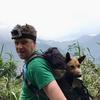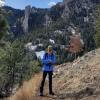With new technologies revolutionizing data collection, wildlife researchers are becoming increasingly able to collect data at much higher volumes than ever before. Now we are facing the challenges of putting this information to use, bringing the science of big data into the conservation arena. With the help of machine learning tools, this area holds immense potential for conservation practices. The applications range from online trafficking alerts to species-specific early warning systems to efficient movement and biodiversity monitoring and beyond.
However, the process of building effective machine learning tools depends upon large amounts of standardized training data, and conservationists currently lack an established system for standardization. How to best develop such a system and incentivize data sharing are questions at the forefront of this work. There are currently multiple AI-based conservation initiatives, including Wildlife Insights and WildBook, that are pioneering applications on this front.
This group is the perfect place to ask all your AI-related questions, no matter your skill level or previous familiarity! You'll find resources, meet other members with similar questions and experts who can answer them, and engage in exciting collaborative opportunities together.
Just getting started with AI in conservation? Check out our introduction tutorial, How Do I Train My First Machine Learning Model? with Daniel Situnayake, and our Virtual Meetup on Big Data. If you're coming from the more technical side of AI/ML, Sara Beery runs an AI for Conservation slack channel that might be of interest. Message her for an invite.
Header Image: Dr Claire Burke / @CBurkeSci

Explore the Basics: AI
Understanding the possibilities for incorporating new technology into your work can feel overwhelming. With so many tools available, so many resources to keep up with, and so many innovative projects happening around the world and in our community, it's easy to lose sight of how and why these new technologies matter, and how they can be practically applied to your projects.
Machine learning has huge potential in conservation tech, and its applications are growing every day! But the tradeoff of that potential is a big learning curve - or so it seems to those starting out with this powerful tool!
To help you explore the potential of AI (and prepare for some of our upcoming AI-themed events!), we've compiled simple, key resources, conversations, and videos to highlight the possibilities:
Three Resources for Beginners:
- Everything I know about Machine Learning and Camera Traps, Dan Morris | Resource library, camera traps, machine learning
- Using Computer Vision to Protect Endangered Species, Kasim Rafiq | Machine learning, data analysis, big cats
- Resource: WildID | WildID
Three Forum Threads for Beginners:
- I made an open-source tool to help you sort camera trap images | Petar Gyurov, Camera Traps
- Batch / Automated Cloud Processing | Chris Nicolas, Acoustic Monitoring
- Looking for help with camera trapping for Jaguars: Software for species ID and database building | Carmina Gutierrez, AI for Conservation
Three Tutorials for Beginners:
- How do I get started using machine learning for my camera traps? | Sara Beery, Tech Tutors
- How do I train my first machine learning model? | Daniel Situnayake, Tech Tutors
- Big Data in Conservation | Dave Thau, Dan Morris, Sarah Davidson, Virtual Meetups
Want to know more about AI, or have your specific machine learning questions answered by experts in the WILDLABS community? Make sure you join the conversation in our AI for Conservation group!
No showcases have been added to this group yet.
- @kgkelly
- | He/Him
Alberta Biodiversity Monitoring Institute (ABMI)
I am an ornithologist with a particular interest in passive acoustic monitoring and AI solutions.
- 0 Resources
- 0 Discussions
- 6 Groups
- 0 Resources
- 0 Discussions
- 4 Groups
- @iainhook
- | Mr
Passionate supporter of New Zealands predator free 2050 goals. Founder of both eTrapper Ltd - offering IoT solutions to enhance efficiencies of conservation projects, and Maungakiekie Songbird - a community based project to enhace local habitat around One Tree Hill in Auckland.
- 0 Resources
- 1 Discussions
- 6 Groups
- 0 Resources
- 0 Discussions
- 12 Groups
https://www.songquanong.com/
- 0 Resources
- 0 Discussions
- 5 Groups
Systems Engineer at Edge Impulse, experiencce with hands-on edge machine learning for wildlife conservation

- 1 Resources
- 2 Discussions
- 4 Groups
- @TMonteiro
- | she/her
- 0 Resources
- 0 Discussions
- 4 Groups
- 0 Resources
- 4 Discussions
- 7 Groups
- @GeorgeDaroux
- | She/her
I am the Communications Advisor for Zero Invasive Predators, based in Wellington, New Zealand.

- 0 Resources
- 1 Discussions
- 2 Groups
- @melika
- | She/Her
Aarhus University
PhD student at the Center for Quantitative Genetics and Genomics, Aarhus University
- 0 Resources
- 0 Discussions
- 2 Groups
- @rays45693
- | he/him
PhD Student in Computer Science at Rensselaer Polytechnic Institute, working on wildlife conservation using deep learning
- 0 Resources
- 0 Discussions
- 4 Groups
- 0 Resources
- 0 Discussions
- 9 Groups
This May, AI for the Planet Alliance announced the Winners and Finalists for its 2022 call for solutions focused on advancing promising AI solutions that combat climate change and we think you should check them out!
25 May 2023
In this Conservation Tech Showcase case study from Happywhale, you’ll learn about how AI tools are helping researchers and citizen scientists identify and protect humpback whales.
16 May 2023
The new role will support the growth of BioSciences’ new People and Nature Laboratory at UCL East through conducting cross-disciplinary research, teaching, outreach, and entrepreneurial activities in applied ecological...
16 May 2023
Are you using or creating tech to protect wildlife? We want to support your organization through two $15,000 grants!
15 May 2023
How can you use tools like photo quadrats, AI, and MERMAID together? We share an example overview of how WCS Staff in Mozambique use image classification tools with MERMAID to integrate photo quadrat and other coral...
12 May 2023
We've now wrapped our 2023 AI for Conservation Office Hours, where we helped conservationists connect with AI experts to get tailored expert advice on AI and ML problems in their projects
11 May 2023
Why you should know about Kenya-founded data analytics company - Gro Intelligence, arguably the largest funded tech startup within the African startup ecosystem and the only platform that brings together live, global...
5 May 2023
Here's an innovative project from the Harvey Mudd College Bee Lab that could help us understand how bees view their environments, and thus better protect bee habitat. This project uses computer vision and drone imagery...
5 May 2023
3 year position - Trondheim, Norway
2 May 2023
Article on www.nationalgeographic.com
27 April 2023
WWF's recent Fuller Seminar Series on Artificial Intelligence and Conservation featured some familiar faces from the WILDLABS community, including our past Tech Tutor Lily Xu! Check out her presentation talking about AI...
26 April 2023
August 2025
event
September 2025
event
event
event
event
October 2025
event
event
event
December 2025
event
March 2026
December 2022
November 2022
event
October 2022
event
17 Products
Recently updated products
| Description | Activity | Replies | Groups | Updated |
|---|---|---|---|---|
| Hats off to your team for this absolute game-changing technology! We rescue stray and wild animals in Taiwan, and the bulk of our work is saving animals maimed by wire snares... |
+37
|
AI for Conservation, Drones, Emerging Tech, Human-Wildlife Coexistence, Wildlife Crime | 8 months 3 weeks ago | |
| There's quite a few diy or prototype solutions described online and in literature - but it seems none of these have made it to market yet as generally available fully usable... |
|
AI for Conservation, Camera Traps, Human-Wildlife Coexistence, Sensors | 8 months 4 weeks ago | |
| As others have said, pretty much all image models at least start with general-subject datasets ("car," "bird," "person", etc.) and have to be refined to work with more precision... |
+20
|
AI for Conservation, Camera Traps | 9 months ago | |
| This is a thread for anyone who has questions about AI for Conservation Office Hours 2025.We're once again teaming up with Dan Morris from... |
|
Acoustics, AI for Conservation, Camera Traps, Community Base, Geospatial | 9 months ago | |
| One thing I love about software is that in an ever-changing landscape of languages, frameworks, and tools, you can never stop learning.... |
|
Software Development, AI for Conservation | 9 months ago | |
| Hi Eugene!Interesting project!I already signed up to test it!Cheers,Lars |
|
AI for Conservation, Camera Traps | 9 months 1 week ago | |
| I am certainly a somewhat vertical thing with a lump on top, so I get it... |
|
AI for Conservation | 9 months 2 weeks ago | |
| Hi all! I wanted to open a discussion on a topic that I've been thinking about ever since I entered the job market-- how to get a... |
|
Software Development, AI for Conservation, Early Career, Open Source Solutions | 9 months 3 weeks ago | |
| That's great, thanks Lars! |
|
AI for Conservation | 9 months 3 weeks ago | |
| I did a short presentation on our work with the polar bear alarm in the Wildlabs Variety Hour October 30th.It can be found here : https://www.youtube.com/watch?v=zr2Q8bUJZ8U... |
|
Human-Wildlife Coexistence, AI for Conservation | 9 months 3 weeks ago | |
| Comma.ai would be your best bet. Not sure if it's officially open source but was started by a noteable hacker with an open source ethos. Could try reaching out to them. |
|
AI for Conservation | 10 months ago | |
| For the record now that this is here:This error typically occurs when the wrong number of classes is given to timm.create_model. You should try to specify num_classes=30... |
|
Camera Traps, AI for Conservation | 10 months ago |












































